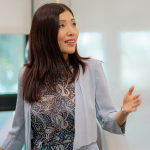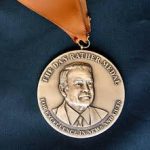MPMT Senior Fulfills His Dream of Covering the Consumer Electronics Show
By Jacob Sedesse, Media Production, Management and Technology senior
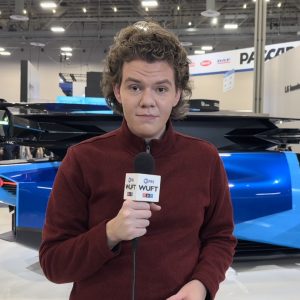
Anyone who has followed my work throughout my life—and especially at the University of Florida College of Journalism and Communications (UFCJC)—would know I’m deeply curious about technology.
I was raised around computers by my mother, who has worked in UF Information Technology my whole life. I became a passionate tech guru following the gospel of Steve Jobs since I was around six years old. I read tech news sites like The Verge, CNET, MacRumors and others to keep up on the industry, following all the latest iPhone and iPad developments. I attended P.K. Yonge, UF’s developmental research school, where I worked in the school’s IT Department in my off-hours. I later placed second in the nation in the Certiport Microsoft PowerPoint championship and advised Microsoft officials on policy as part of their Council for Digital Good when I was just in high school.
Family and friends expected me to take all of this experience and study engineering or computer science. I tried both as a dual enrollment student at Santa Fe College, but—as I discovered—they were not for me.
I changed my major and graduated from Santa Fe with a theatre degree during high school, but I always knew I had an inkling of wanting to work in media. I grew up watching YouTube since it first started, encountering technology-related content creators like iJustine. They pioneered the concept of vlogging—a fun twist on self-journalism and documentary.
So, I took my passion to the press.
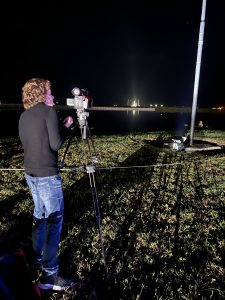
While majoring in Media Production, Management, and Technology and specializing in Film and Television Production, I made the cross over into news to indulge my theatrical desires at the anchor desk for WUFT-TV, the College’s local PBS affiliate. I also brought my tech savvy to the TV screen.
I started a technology segment for TV called Tech Tomorrow and covered the NASA Artemis I launch. I joined Snap Inc.’s Safety Advisory Board, where I have been able to help redefine how engineers design platforms to foster safe interactions for kids online. I found ways to indulge my passion locally, covering Gainesville-based game studio Grove Street Games as they launched a new title in fall 2023.
But I still had more left to accomplish. In the words of Steve Jobs, I still had one more thing.
As a passionate follower of technology media sites and content creators, I always saw one shining beacon on the hill—a crowned jewel that I knew I had to be there for, if even just once: the Consumer Electronics Show in Las Vegas. The show has hosted the biggest names in technology showing their most impressive innovations annually for over 50 years.
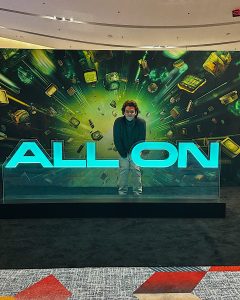
But I didn’t just get to go. I got a front row seat—covering it as a member of the press for WUFT.
This year’s event took place across six days with two just for the media. I rubbed shoulders with industry greats—both in tech and in journalism—while shuffling through seminars led by giants like Samsung, LG, Siemens, Sony and others held exclusively for more than 2,000 members of the press. When the floodgates opened to the other 130,000 attendees, the show unfolded across the entire city, hosting wall-to-wall exhibits in the Las Vegas Convention Center, the Westgate, the Venetian Expo Center and Mandalay Bay.
As deep into the industry as I am, I was floored by so many of the prototypes. I had startup leaders tell me their elaborate plan to get flying cars into the skies. I saw a computer I could control with brain signals. I played with robots that could mow your grass, clean your pool or just play. I put on a bodysuit that made me feel like I was being touched by objects in a virtual world. And I saw straight through a TV with a transparent screen. These weren’t just sales pitches—they were products I got to try firsthand.
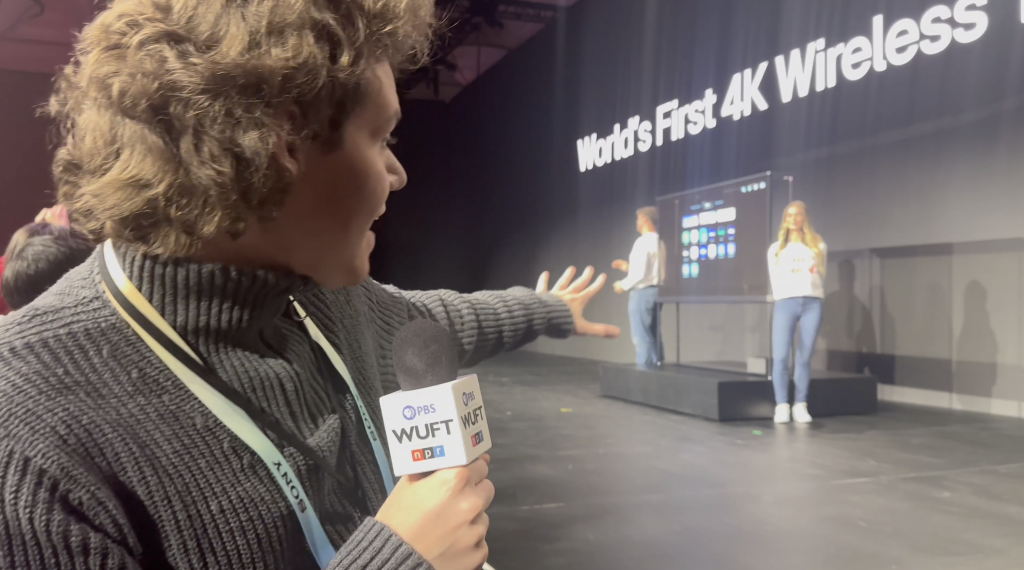
It was a whirlwind and certainly a bigger undertaking than anything I’ve ever covered before. But it’s even more daunting considering I had to do it all by myself—armed with just my iPhone and an arsenal of accessories loaned to me by my WUFT family.
Luckily, I had a friend to help me off the ground—a veteran technology reporter who just so happened to be a UFCJC alumna: Bridget Carey, B.S. Journalism 2006, a principal video producer for CNET.
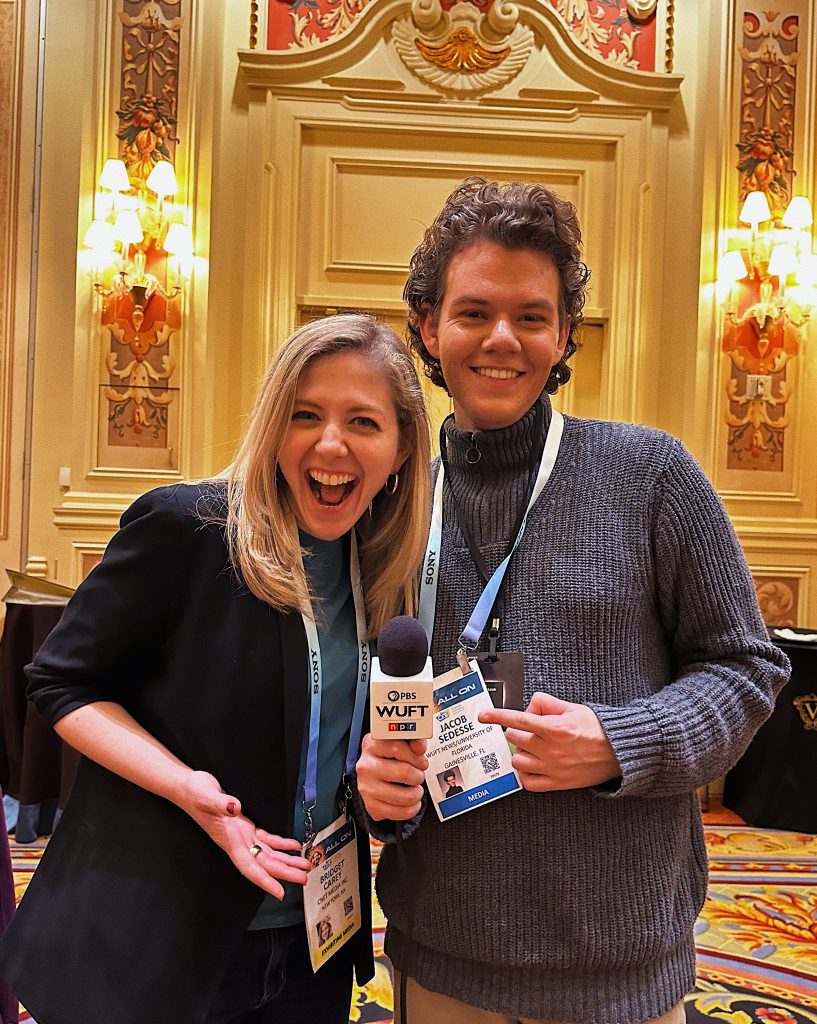
In the same way I flip-flop between the worlds of film and news, Carey found herself stuck between the worlds of print and TV when she was a UFCJC student. She pressed forward down the print path, serving as editor-in-chief of the Independent Florida Alligator and working her way up to the Miami Herald’s business desk.
“That’s how I started to kind of get my toes in the water with technology reporting,” Carey said. “Back then, we would experiment with video and just had a lot of fun doing product reviews from a webcam in my bedroom.”
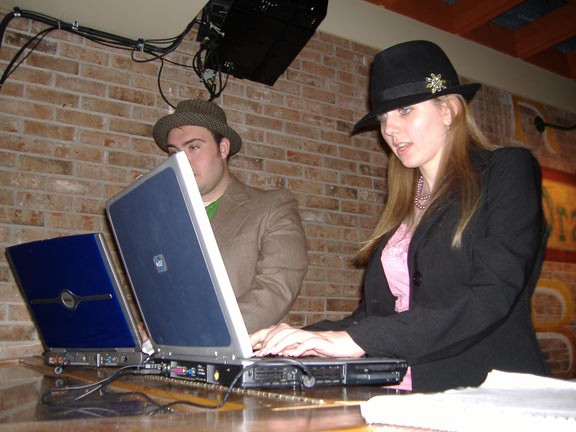
She continued down that path and ended up as the principal video producer at CNET—a site I grew up reading. She is a former member of the Journalism Department’s Advisory Council, and my professors consistently encouraged me to reach out to her. I never knew what to say, but her job always seemed like a dream for me and the timing felt right as I was getting ready to leave for Vegas. Little did I know, Carey was also getting ready to cover the event, as she has for 12 years, with a massive team to assist her.
“When I got your email, I was so excited,” Carey said. “I was so proud that you said ‘I’m gonna take this on,’ and that you made the pitch and you got to go.”
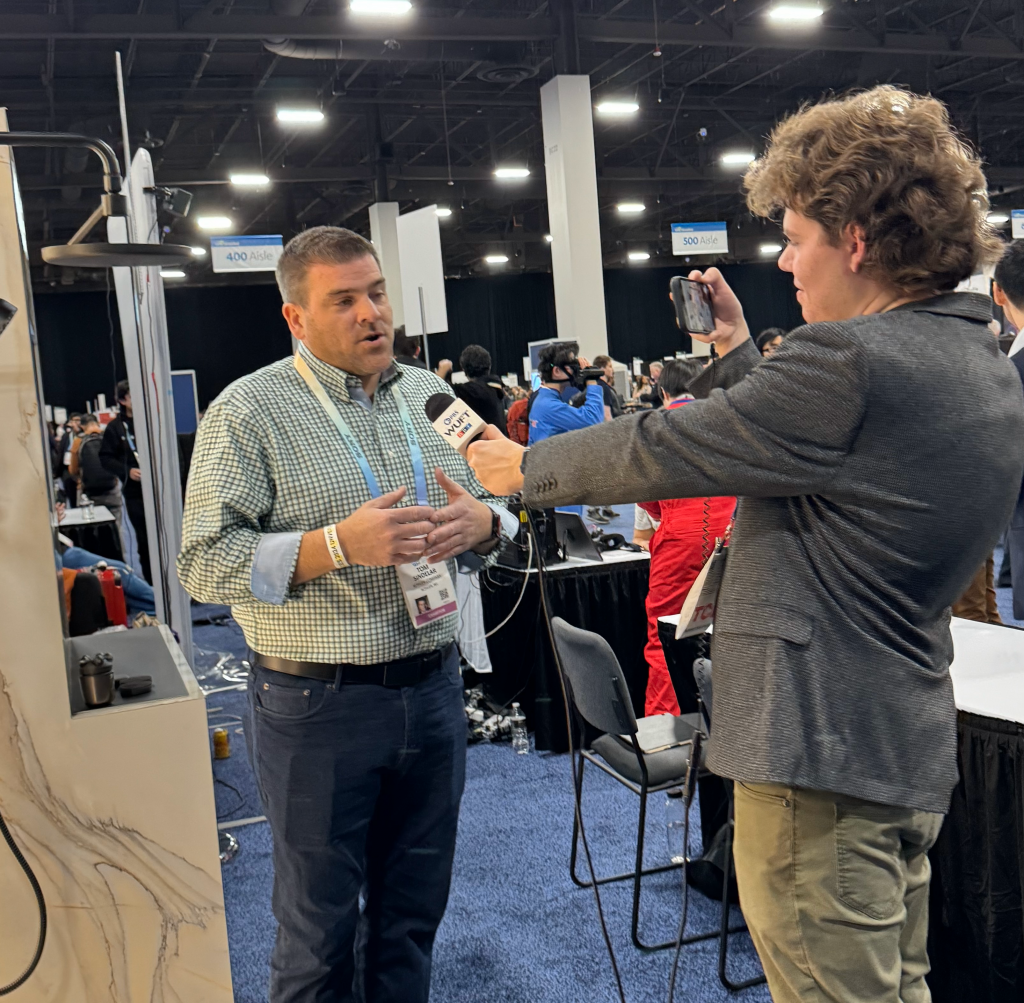
I found Carey completely by accident on the very first media day. We ran smack into each other amidst rows of exhibitors showing off inventions from homemade beer brewers to smart jewelry. She immediately gave me a crash course and introduced me to members of her team. We worked adjacently throughout the event, and, even amidst the stress of the week, she stopped to take photos of me at work and found time to text me droplets of advice every night.
“I hope you got some good stuff tonight,” Carey texted me on the first night of the event. “Think about potential things tonight that could be expanded if you are doing any themes.”
I compiled my experiences into WUFT at CES 2024, a multimedia roundup of all the best things I saw at the event. It materialized as a series of one-minute television stories that aired throughout the following week on WUFT’s student-run First at Five newscast, as well as a 2,000-word report for our website, WUFT.org. I split each section up by a key industry represented at the event, including transportation, health, home and entertainment—with AI playing a role in all the categories. It’s hard to summarize the amount of ground I covered at a breakneck pace every day—you just have to see it for yourself.
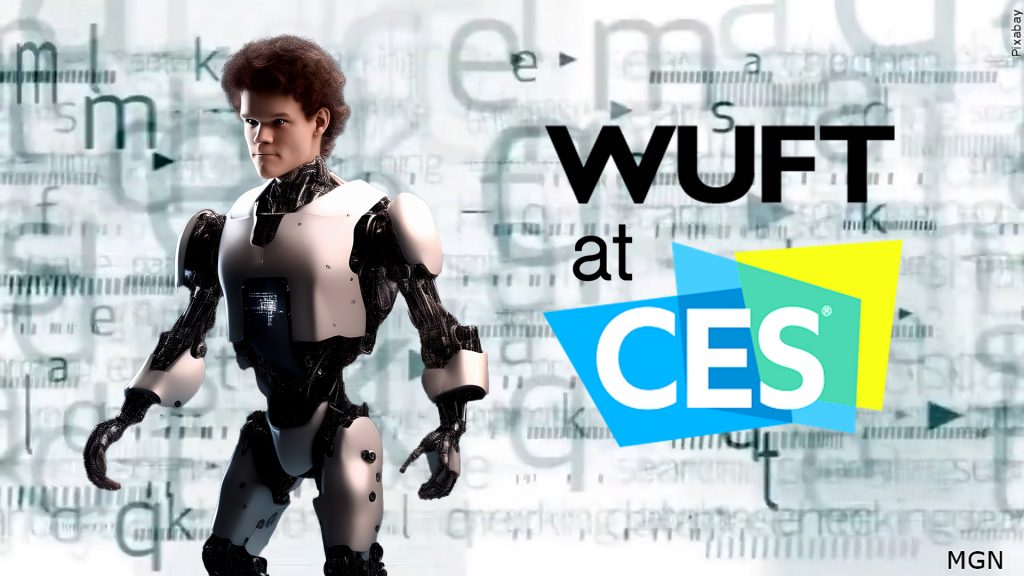
As I fledged out the final product, Carey told me to keep her in the loop. I anxiously awaited her response.
“To even attempt a bite of it—you successfully got four bites out of it,” Carey said. “That in itself is very admirable.”
She expressed an affinity for one small clip: a shot of myself riding the Las Vegas Monorail.

“I loved that shot,” Carey said. “When you get so focused… you forget to take the slice of life images. So much of the story people want to hear about is the journey it takes to get there.
That shot, like most of the avant-garde and non-traditional parts of the production, were shot on my iPhone attached to a selfie stick.
“I think we are in an age now where the audience appreciates it when it doesn’t look so polished,” Carey said. “Our most successful videos were the ones where we just held up the phone.”
On the other hand, much of the work by Carey’s CNET team was massive in scale and stands as an example of world-class coverage of one of the industry’s biggest stories every year. She coordinated her work with team members from the website and social media, mostly focusing on producing individual feature stories alongside event wrap-up pieces.
One such piece of hers that I personally love is “The Quirky, Cool and Unusual at CES 2024.” I’ve been showing it to professors and mentors to explain who Carey is and what I want to do with my life. She, with her vibrant on-air personality, turned her nose to the high-budget presentations from mega-corporations and spotlighted the most downright bizarre products you won’t find on the main floor.
“[It’s] a whole other smaller area that you just kind of find yourself wandering through hallways going, ‘there’s a robot on the floor,’ and ‘why is that plant moving?’” Carey said.
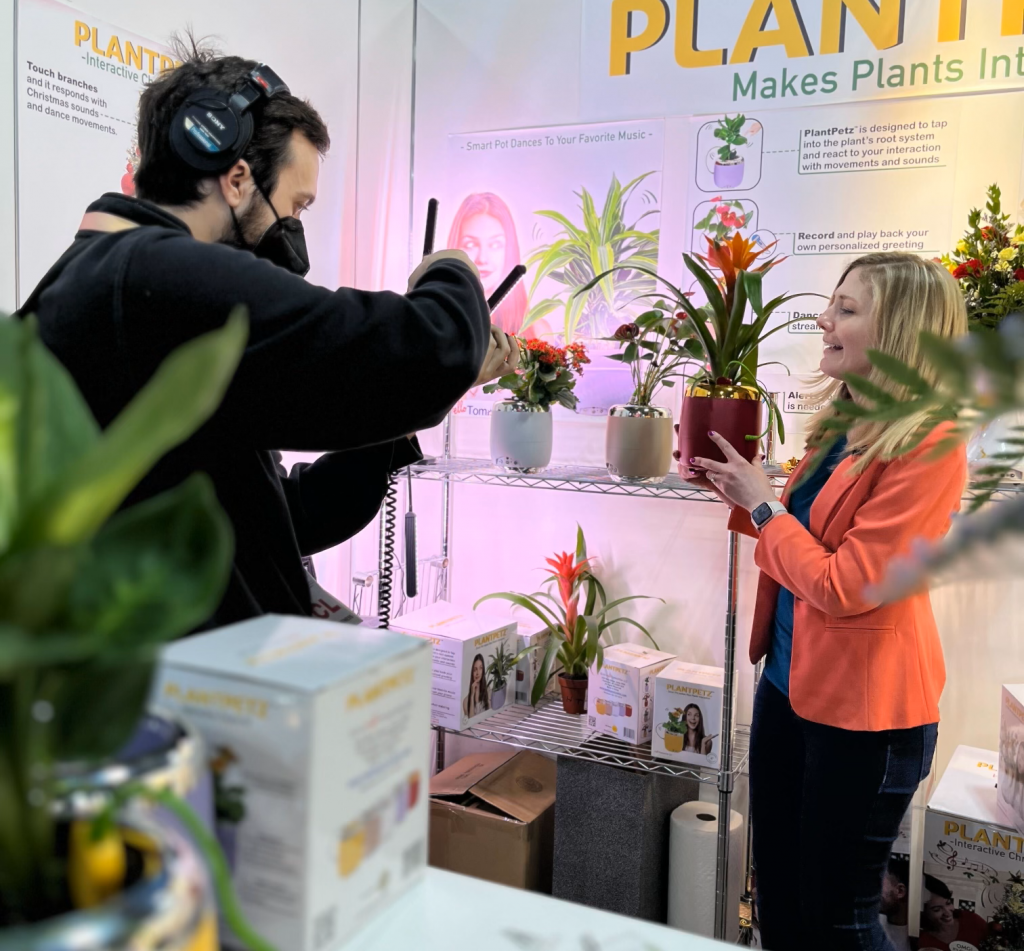
She’s referring to a company that showed off a device that makes your plants move and act like pets. During the show, she also pointed me to a robot that could paint nails—I held up my single grey-painted fingernail for her in our interview. (Carey asked her producer to get the mani in her stead as she already had a fresh set.)
With such a wide gamut of products on display across such a wide area, it can be hard to even stomach the thought of tackling such an undertaking. But Bridget credits her studies at the University of Florida with preparing her for the work. She recalled covering a John Kerry rally in Journalism Master Lecturer Mike Foley’s first reporting class as a key moment in learning what it means to be a reporter at such a big event.
“You have to realize I’m not here to reinvent the wheel,” Carey said. “I just need to kind of touch and say I’m here and experience it all.”
In our interview, I shared a similar feeling I got when I covered the Artemis I launch. I described a feeling of imposter syndrome—but I learned to quickly set it aside.
“You will rise to the occasion,” I said. “Even if it’s something that’s larger in scale, it’s the same fundamentals.”
It might seem silly to liken covering the latest technology to such mainstream stories. With so much going on in the world, many would argue that it’s not important to show off the latest technology. But Bridget and I both see the purpose of these events differently.
“Tech touches our lives in so many ways, whether it’s navigating a simple thing like, ‘How do I make this thing work?’ or ‘Do I really need to upgrade?’,” Carey said. “A lot of tech reporting is helping be an advocate for consumers.”
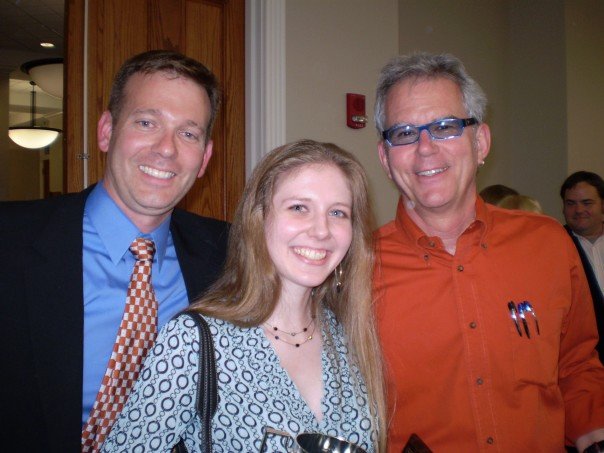
I compared our roles as tech journalists to scholars of our fields. As students of communications, we have a unique knowledge base to tackle the tech industry: Not only can we provide analysis on the communications platforms of the future through an ethical and theoretical lens, but we also are equipped to see through the marketing tactics of the communications specialists presenting products on behalf of corporations.
We also do it just because it’s inspiring. Carey likened CES to the original vision for EPCOT, the Disney theme park two hours south of Gainesville. Walt Disney envisioned it as a true city of the future and as a tourist attraction, and it became an expansive expo designed to give a glimpse of what life might be like in the future when enhanced with the latest innovations. As an avid theme park fanatic, I agreed.
But like EPCOT, there’s an element of magic at CES that gets foiled when you look behind the curtain.
As an armchair observer of the event from home, I always saw CES as a glamorous spectacle—which it undoubtedly is. But once I saw it in person, unfiltered by others’ coverage, I realized that the journalists are the ones responsible for the magic. The event is a full of start-up companies with few resources but cool products that they just cannot otherwise get the world to see. We have to take a prototype sitting on a folding table and find the potential to highlight.
But amidst the hustle and picking apart how you can sell these visions of the future to viewers at home, you still get the sense that the magic is truly there—you can feel it buzzing in the air everywhere you go. It certainly happened for me on day one, when I crossed paths with my childhood idol iJustine—whose real name is Justine Ezarik—as she was hosting the event. I caught a glimpse of her as she was ascending from a full-body massage chair and walked straight up to her. I breathlessly told her about all my work and declared that I wanted to be a tech journalist. She stopped me mid-sentence:
“Look at you, you’re doing it!” she said excitedly.
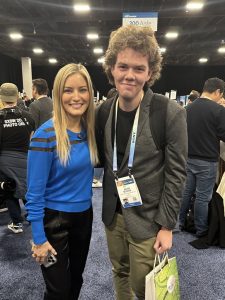
I thanked her for the impact she had on my life and we snapped a picture. I recounted it to Carey afterwards.
“I know it seems so silly,” I said.
But she agreed that Justine had a massive impact on our field. I recounted growing up as a child watching her struggle to buy the first iPhone and play around with the first iPad while dressed in a costume. I remembered watching her vlog her way through her very first CES just over a decade ago—a time when people did not look at online content creators as highly as they do today, and she was still getting her feet off the ground. It reminded me of my own experience that week, as a student journalist working among the titans I admired—all while witnessing my own shimmering glimpse of utopia.
And then I remembered that I’ve only seen one year—and that there will be a whole new slate of technologies to discover next year.
“It really always wows me and always surprises me,” Carey said. “Every year you always think ‘I’ve seen it all, surely I’m a jaded tech reporter by now.’ But there’s always something unexpected and amazing.”
Category: College News, Profiles
Tagged: Bridget Carey Consumer Electronics Show Jacob Sedesse
Subscribe to our News Digest

